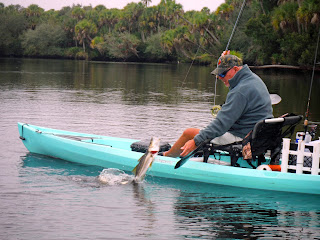 |
| Mick Coulas stands and casts from a NuCanoe Frontier. |
Fly fishing from a kayak can be a frustrating and somewhat
difficult endeavor. But it doesn't need to be.
In fact, once your understand the nuances, it's really quite
simple.
I fish out of a NuCanoe Pursuit (http://www.nucanoe.com/pursuit-fishing-kayak/),
a boat that I strongly feel is the best kayak for fly fishing available. It's
very stable, so standing a casting is easy. It's cockpit is spacious and
uncluttered, so line management is a breeze.
 |
| Fly rod storage is simple in the Pursuit. |
I feel that pedal kayaks should be left to spin fishers who
are convinced they need to cover large amounts of water. They're not great for
fly fishing. The pedals are not only great for propelling the kayak, but even
better at grabbing fly line.
I like to keep things as simple and uncluttered as possible.
With the Pursuit, I can carry up to three extra fly rods and
stow them out of the way in the internal rod tubes. These rod tubes really do
the job.
When it comes to fly fishing from a kayak, casting distance
is the key. The longer you can cast, the more water you can cover and the
greater your chances are of hooking fish.
Realize, however, that one of the main benefits of fishing
from a kayak is that you don't have to be as far away from your target as you
would be in a powerboat. Rather than having to make 80-foot casts, you can more
to within 40 or 50 feet of your target.
Those distances, however, can be a chore for many anglers.
And it gets a tad tougher when you're sitting in a kayak.
 |
| The author gets ready to land a snook. |
There are ways to increase your casting distance.
The best way is to stand up. If you're fishing from a
NuCanoe Pursuit or Frontier, that's no problem. Both kayaks are perhaps the
most stable fishing vessels out there. The Pursuit is 35 inches wide; the
Frontier is 41. You can stand with great confidence.
If you must sit, there are ways to increase your distance. First,
take only the amount of line off the reel that you need to cast. If you're
going to cast 50 feet, there's not need to take 60 feet of line off the reel.
Make sure your backcast is high. You don't need your fly
line hitting the water on the backcast.
To increase distance, I like to do a "water haul"
on my forward cast. I allow the fly to "tick" the water, then pick it
up immediately, allow the line to unroll fully on a backcast, then shoot it forward.
 |
| Fly fishing from a kayak is simple and effective. |
Works like a charm.
Gaining distance will be no problem for those who can double
haul, a technique that allows you to shoot line on both the forward and back
casts, and increase line speed.
When fly fishing, I prefer to anchor my kayak in many
situations. I have and anchor trolley on all of my kayaks, so I can allows have
the wind at my back or face the direction I need.
One of the biggest mistakes many folks make is keeping the
tip of their fly rod too high off the water. This puts unneeded slack into the
line. If your rod tip is 18 inches off the water's surface, the fish then has
to pull 18 inches before you'll even know you have a hit.
Put that rod tip IN the water or on the water's surface. The
rod should also be pointed directly down the fly line.
I have watched many clients reel up slack line to "get
the fish on the reel" too often. In most cases, that's not only
unnecessary, but also can result in slack line and a lost fish.
Let the fish tell you whether it needs to "be on the
reel." If the fish is large enough and strong enough, it will take line
and you'll be on the reel.
Most fish can be "hand-stripped" in.
For most fish, the reel 's only purpose is to hold the line at the end of the trip!
I like to carry two or three rods so that I can
"work" the water column. I'll take one rod with a full floating line,
one with a sinktip line and another with a sinking line. That way, I can work
the water column from top to bottom.
When fly fishing, you can travel fair light. In addition to
your rods, all you'll need is a fly box with all the flies you'll need, extra leaders and tippet material. You'll
also want to carry pliers, nippers and a landing tool or net.
When you're fly fishing, you can catch most any fish that
swims in salt or fresh water.
And when you're in the right kayak, your odds of success
simply skyrocket!
Dead on about those pedals, and you should put a disclaimer on how addictive it is.;)
ReplyDelete